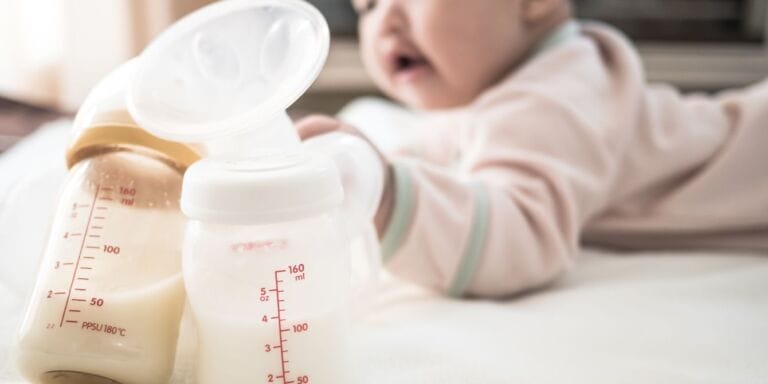The wearable Willow breast pump is setting moms free

How it works, and how to use insurance to get one.
When mom of two Nicole Phelps snapped a selfie showing her pumping at a formal event, hands-free, while wearing an evening gown, her Instagram notifications blew up. Among the clapping emojis and many variations on “YAAAAAASSSSS” there was one comment that came up again and again: “What pump is it? I want it!”
Over and over, @mrs.nicolephelps responded, letting Instagram followers know the tubeless, cordless, wearable pump she stuck into her evening gown is a Willow. Some commenters were familiar with the pump, which hit the market earlier this year, but for others, Phelps’ selfie was the first they’d hear of the invention.
“There are wireless pumps??? love that idea!” wrote one commenter.
So did Time magazine. They called it one of the best inventions of 2017.
data-instgrm-captioned data-instgrm-version=”4″ style=” background:#FFF; border:0; border-radius:3px; box-shadow:0 0 1px 0 rgba(0,0,0,0.5),0 1px 10px 0 rgba(0,0,0,0.15); margin: 1px; max-width:658px; padding:0; width:99.375%; width:-webkit-calc(100% – 2px); width:calc(100% – 2px);”>
Willow’s CEO, Naomi Kelman, was pleased by the reactions to Phelps selfie, not just because the picture spread the word about her product, but because the message Phelps was sending is the same one she preaches: Moms shouldn’t have to drop what they’re doing and go hide in a bathroom in order to pump.
“We see Willow as part of a larger effort to better the lives of women,” Kelman tells Motherly. “Mothers told us that they wanted to be able to get their lives back.”
The Willow’s unique form factor frees moms from common issues that make pumping on the go difficult. It can be tucked into your existing bra and worn around, so you don’t have to strip down the way moms have done in order to go hands-free with other pumps, and it doesn’t need to be plugged in, so moms aren’t left searching for an outlet (like the mom who recently went viral after she couldn’t plug her pump in during a flight).
One mom commenting on Phelps’ post recalled how she once found herself in “a bathroom in NYC sitting on the floor so I could access the power outlet” while using a traditional pump. Her expirience stands in contrast to another Instagram user, who’s felt more freedom since using the Willow.
“I’m an RN (NICU RN) and I pump at work in the break room, running to get food and I’ve pumped while providing emergency care to one of my NICU babies,” she commented on Phelps’ selfie.
According to Kelman, stories like that aren’t unique. She recalls hearing from a mom who is a dermatologist who pumped for her first child for nine months using a traditional pump. “She talked about the challenges of being pushed into supply closets even in a hospital,” Kelman says.
The Willow changed things for that mom, according to Kelman, allowing her to pump while meeting with patients, and she was able to pump until 14 months with her second child.
The discrete wearability of the Willow is one reason moms are loving it, but the “smart” factors of this high-tech pump are also lauded in the comments section of Phelps’ selfie. According to Kelman, the Willow app is different from apps for other pumps, because users don’t have to go to the trouble of entering their own data, the Willow keeps track. The intuitive response of the Willow to a breast let down (going from stimulation mode to extraction mode) is another way the pump is “smart.”
“I actually noticed an increase in overall volume with my @willowpump,” one mom noted in Phelps’ comment section. “I think some of it is being able to see the suction level with the app combined with being able to pump when I need to, not waiting a half hour till I could get to an outlet to plug in.”
While plenty of moms chimed in on Phelps’ Instagram post with praise for Willow, as Phelps herself noted, the pump is not without criticism and while she loves it, “It’s not for everyone.”

The pump is available in white and grey.
Willow
The most common complaint about the Willow pump is the price. At $479.99, it’s at least $100 more than the Medela Freestyle double pump (which often retails for $379.99 but can currently be found on sale).
For some moms, having a pump that doesn’t need a bunch of tiny (and easily forgettable) accessories, is well worth the extra investment, but Kelman understands that cost is a barrier. She says she is working hard on making Willow more accessible to more moms. “We’re actively seeking to get insurance coverage because we recognize that that’s super important and we want Willow to be available to all women,” she tells Motherly, adding that the insurance companies’ processes have been slower than the team at Willow would like.
“In the meantime, women can use insurance via their HSA or FSA account, and also we’re finding that a lot of women are asking their insurance companies to cover as an out-of-network pump and are having huge success,” says Kelman.
The Willow also can’t be shipped internationally yet, but the team does hope to make it available in the future.
It took a long time for the world to get a breast pump like Willow, and it’s probably going to take a little while longer for the world at large to get on board, but judging by the reaction to Phelps’ instagram post, moms already are.


































